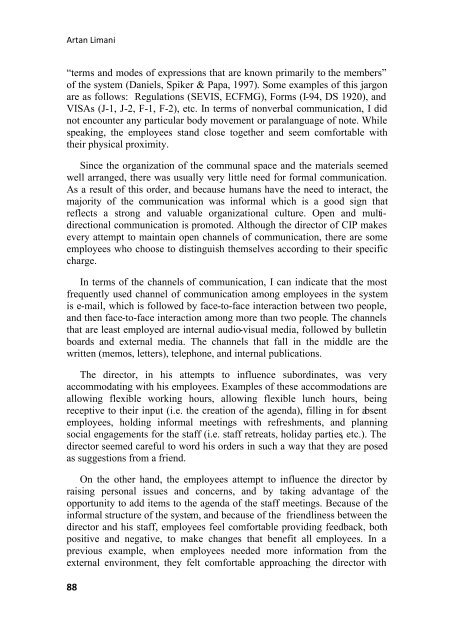SEEU Review vol. 6 Nr. 2 (pdf) - South East European University
SEEU Review vol. 6 Nr. 2 (pdf) - South East European University
SEEU Review vol. 6 Nr. 2 (pdf) - South East European University
You also want an ePaper? Increase the reach of your titles
YUMPU automatically turns print PDFs into web optimized ePapers that Google loves.
Artan Limani“terms and modes of expressions that are known primarily to the members”of the system (Daniels, Spiker & Papa, 1997). Some examples of this jargonare as follows: Regulations (SEVIS, ECFMG), Forms (I-94, DS 1920), andVISAs (J-1, J-2, F-1, F-2), etc. In terms of nonverbal communication, I didnot encounter any particular body movement or paralanguage of note. Whilespeaking, the employees stand close together and seem comfortable withtheir physical proximity.Since the organization of the communal space and the materials seemedwell arranged, there was usually very little need for formal communication.As a result of this order, and because humans have the need to interact, themajority of the communication was informal which is a good sign thatreflects a strong and valuable organizational culture. Open and multidirectionalcommunication is promoted. Although the director of CIP makesevery attempt to maintain open channels of communication, there are someemployees who choose to distinguish themselves according to their specificcharge.In terms of the channels of communication, I can indicate that the mostfrequently used channel of communication among employees in the systemis e-mail, which is followed by face-to-face interaction between two people,and then face-to-face interaction among more than two people. The channelsthat are least employed are internal audio-visual media, followed by bulletinboards and external media. The channels that fall in the middle are thewritten (memos, letters), telephone, and internal publications.The director, in his attempts to influence subordinates, was veryaccommodating with his employees. Examples of these accommodations areallowing flexible working hours, allowing flexible lunch hours, beingreceptive to their input (i.e. the creation of the agenda), filling in for absentemployees, holding informal meetings with refreshments, and planningsocial engagements for the staff (i.e. staff retreats, holiday parties, etc.). Thedirector seemed careful to word his orders in such a way that they are posedas suggestions from a friend.On the other hand, the employees attempt to influence the director byraising personal issues and concerns, and by taking advantage of theopportunity to add items to the agenda of the staff meetings. Because of theinformal structure of the system, and because of the friendliness between thedirector and his staff, employees feel comfortable providing feedback, bothpositive and negative, to make changes that benefit all employees. In aprevious example, when employees needed more information from theexternal environment, they felt comfortable approaching the director with88
















